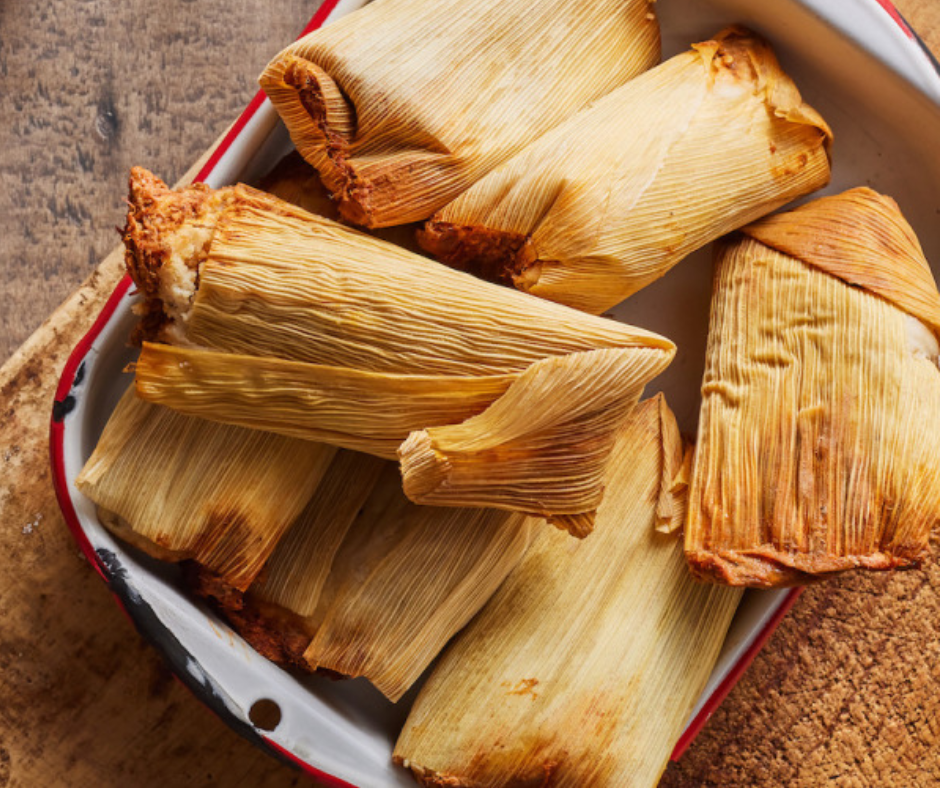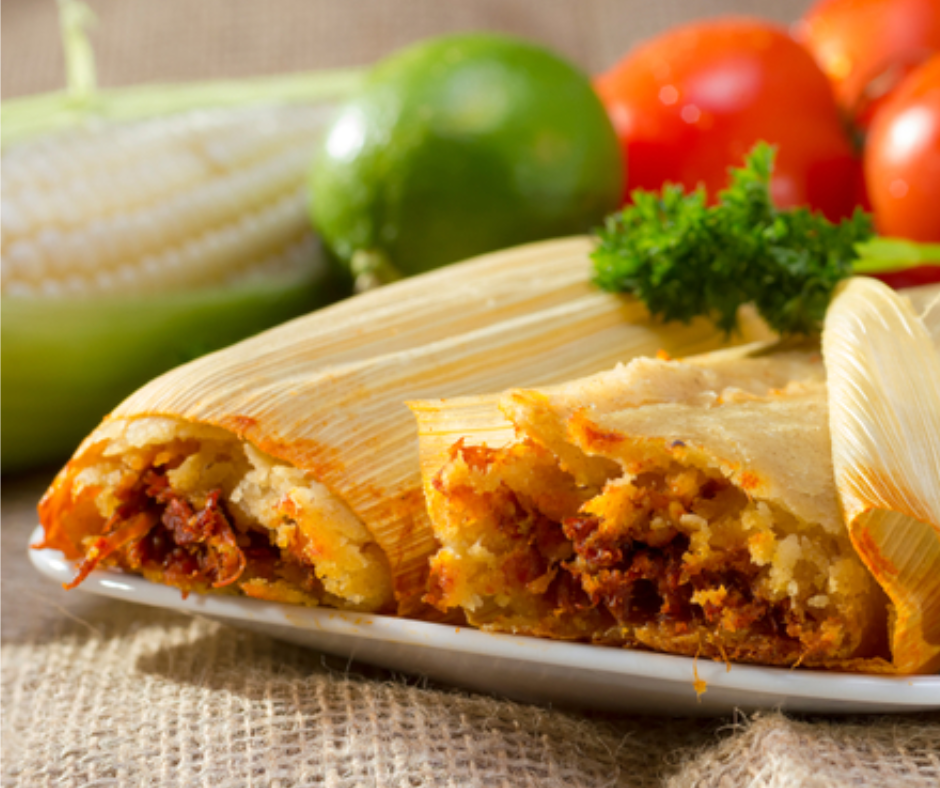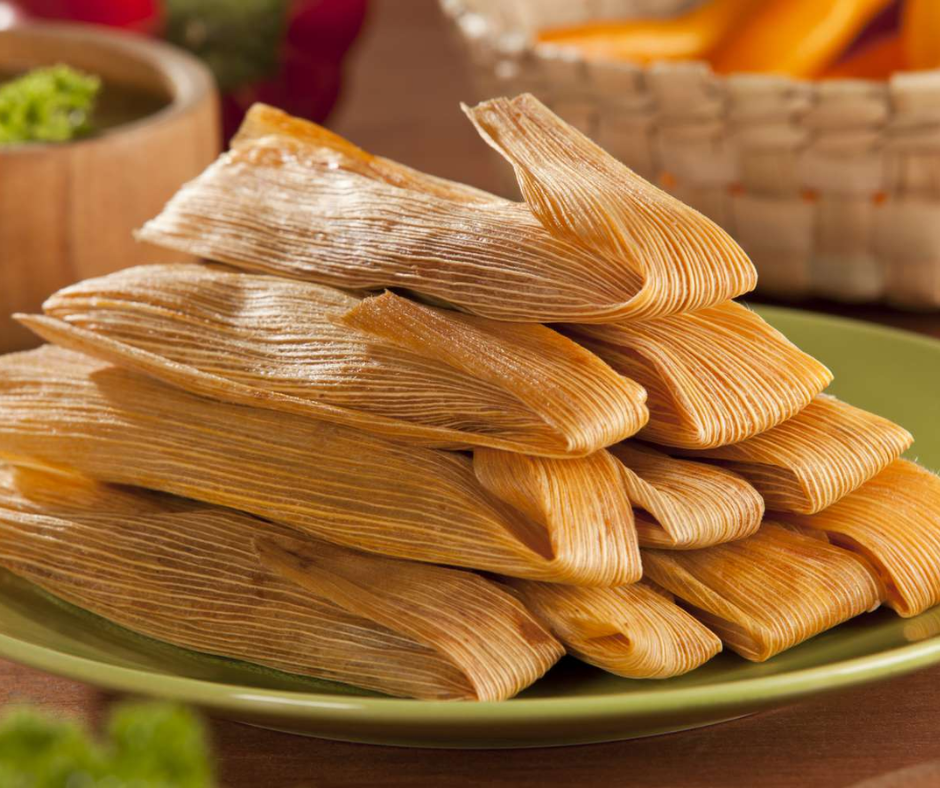Introduction
Mexican cuisine is renowned for its vibrant flavors and unique cooking techniques. One traditional method that stands out is using corn husks to wrap various dishes. But What Mexican Food Is Wrapped in Corn Husk? Among them, tamales are the most well-known. However, other delicious Mexican foods are also wrapped in corn husks. In this article, we will explore the tradition of wrapping Mexican food in corn husks and delve into the significance of corn husks in Mexican cuisine.

The Tradition Of Wrapping Mexican Food In Corn Husks
Using corn husks to wrap food is deeply ingrained in Mexican culinary heritage. Tamales, a beloved Mexican dish, consists of masa (a dough made from corn), seasoned meat or other fillings, and various seasonings, all wrapped in a corn husk. The filled husks are then steamed until the masa is cooked and the flavors are infused.
Apart from tamales, other Mexican delicacies share this traditional method of cooking. One example is the Zacahuil, a large tamale typically filled with pork, chicken, or beef. Another is the Chuchitos from Guatemala, which are similar to tamales but smaller.
The Significance Of Corn Husks In Mexican Cuisine
Corn is a staple crop in Mexico, and its importance in the cuisine cannot be overstated. Corn husks are vital in enhancing the flavors and textures of the foods they wrap. The husks provide a natural, earthy aroma that infuses the dish during cooking, creating a distinct and appetizing flavor profile.
Moreover, corn husks help to keep the fillings moist and tender by trapping the steam as the food cooks. This results in a juicy and succulent texture characteristic of many Mexican dishes. Additionally, the husks act as a barrier, preventing the masa or other fillings from sticking to the cooking surface and ensuring the food is cooked evenly.
In conclusion, the tradition of wrapping Mexican food in corn husks is integral to the country’s rich culinary heritage. Tamales and other dishes wrapped in corn husks showcase Mexican cuisine’s unique flavors and cooking techniques. Whether it’s the earthy aroma or the tender texture, corn husks significantly enhance the overall dining experience. So, savor the flavors next time you enjoy a tamale or any other dish wrapped in corn husks and appreciate the cultural roots behind this traditional cooking method.
What Mexican Food Is Wrapped in Corn Husk? – Tamales: A Mexican Delicacy
Definition And History Of Tamales
If you wonder ‘What Mexican Food Is Wrapped in Corn Husk?’, Tamales are the answer you are finding. Tamales are a beloved Mexican dish made of masa, a dough made from corn, filled with various ingredients, wrapped in corn husks, and steamed until cooked. This popular dish has a long history that dates back thousands of years to the ancient Mesoamerican civilizations.
Ingredients Used In Traditional Tamales
Traditional tamales can feature many fillings, including meats like chicken, beef, or pork, and vegetarian options like cheese, beans, or vegetables. The masa is typically made from specially treated corn, soaked in an alkaline solution to remove the husk and soften the kernels. This process, known as nixtamalization, gives the masa its distinct flavor and texture.
Other common tamale ingredients include spices, such as cumin and chili powder, and lard or vegetable shortening to add richness and moisture to the dough.
How Tamales Are Made And Cooked?
Making tamales is a labor-intensive process that often involves the participation of multiple family members or a group of friends. The masa is spread onto a corn husk, and the desired filling is placed in the center. The corn husk is then folded into a neat package, sealing in the filling. The tamales are stacked in a steamer and cooked for several hours until the masa is firm and the filling is cooked.
The Role Of Corn Husks In Steaming Tamales
Corn husks play a crucial role in the cooking process of tamales. They serve as a natural wrapper for the dough and filling and help steam the tamales. The corn husks create a barrier between the tamales and the steamer, allowing the steam to circulate the tamales and cook them evenly.
Once the tamales are cooked, the corn husks are peeled off, revealing the delicious steamed masa and filling inside. The corn husks also add a subtle corn flavor to the tamales, enhancing the overall taste of this Mexican delicacy.
Whether enjoyed as a savory meal or a sweet treat, tamales have become an integral part of Mexican cuisine, representing the country’s rich cultural heritage and culinary traditions. So next time you come across a steaming plate of tamales wrapped in corn husks, you’ll know exactly what you’re about to indulge in – a delicious and time-honored Mexican delight.

Other Mexican Foods Wrapped In Corn Husks
Whether you’re a fan of Mexican cuisine or just beginning to explore its flavors, you may have encountered a popular dish called “tamales.” These tasty treats are made by wrapping a delicious filling in a corn husk and steaming it to perfection. But did you know that other Mexican foods are also wrapped in corn husks? So, What Mexican Food Is Wrapped in Corn Husk? Let’s take a closer look at some of these flavorful delights.
Different Types Of Foods Wrapped In Corn Husks
Mexican cuisine is known for its creativity and use of traditional ingredients. Here are some examples of foods that are wrapped in corn husks:
Popular Examples Of Corn Husk-wrapped Mexican Dishes
-
Tamale Variations
Tamales are undoubtedly the most well-known corn husk-wrapped Mexican dish. They come in various flavors, including savory options like pork, chicken, and beef and sweet options like pineapple, strawberry, and chocolate. Each tamale is a delicious combination of masa (corn dough) and a flavorful filling.
-
Tacos Al Vapor (steamed Tacos)
Tacos al-vapor, also known as steamed tacos, is another Mexican delight wrapped in corn husks. These tacos are made by filling a tortilla with meat, usually beef or chicken, and then wrapping it in a corn husk. They are steamed until tender and served with various toppings, such as salsa, onions, and cilantro.
-
Tlacoyos
Tlacoyos are a traditional Mexican street food made by wrapping maize dough around a filling, usually beans or cheese, and then shaping it into an oval shape. These tasty treats are then cooked on a comal (a flat griddle) and topped with ingredients like salsa, cheese, and cilantro.
-
Pastel De Elote (corn Cake)
Pastel de Elote is a delightful corn cake with fresh corn kernels, butter, sugar, and eggs. The mixture is blended to create a smooth batter, which is poured into a corn husk and then steamed or baked. The result is a moist and flavorful cake that can be enjoyed as a dessert or a side dish.
These are just a few examples of the delicious Mexican foods wrapped in corn husks. Using corn husks not only adds an earthy flavor to the dishes but also helps keep the fillings moist and flavorful. So, the next time you’re exploring Mexican cuisine, don’t forget to try some of these delightful treats wrapped in corn husks.
Why Are Corn Husks Used In Mexican Cooking?
When it comes to Mexican cuisine, corn husks play a vital role in preparing and presenting certain dishes. These papery husks provide a distinct flavor and help retain moisture during cooking. Let’s explore why corn husks are used in Mexican cooking and explore alternative options.
Steaming And Flavor-enhancing Properties Of Corn Husks
- Steaming: Corn husks are known for creating a perfect steaming environment for various dishes. When wrapped in a corn husk, the food is protected from direct heat, and steam is trapped, ensuring even and gentle cooking. This is particularly important for dishes like tamales, where the dough needs to be moist and tender.
- Flavor infusion: The natural flavors of the corn husks seep into the food during the cooking process, imparting a subtle earthy taste. This enhances the flavor profile of dishes like tamales and adds depth to the filling.
Cultural And Aesthetic Reasons For Using Corn Husks
Using corn husks in Mexican cooking also has cultural and aesthetic significance:
- Tradition: Corn holds immense cultural importance in Mexico, and using corn husks to wrap and cook food is a nod to this agricultural heritage. It pays homage to the ancient Mesoamerican traditions and showcases the connection between food and culture.
- Visual appeal: Corn husks lend a rustic and visually appealing touch to dishes. They create a beautiful presentation, adding texture and a natural green color to the finished product.
Alternative Wrapping Options For Corn Husks
While corn husks are the traditional choice, there are alternative options for wrapping Mexican dishes:
- Plantain leaves: In some regions of Mexico and other Latin American countries, plantain leaves are used as a substitute for corn husks. They provide a similar steaming and flavor-enhancing effect.
- Foil: Foil can be a practical alternative to corn husks when preparing certain dishes. However, it does not offer the same infusion of flavors as corn husks or the rustic aesthetic.
- Parchment paper: In some cases, it can be used as a substitute, although it may not provide the same moisture retention level as corn husks.
In conclusion, corn husks are integral to Mexican cooking due to their steaming properties, flavor infusion, cultural significance, and visual appeal. While alternatives like plantain leaves, foil, and parchment paper can be used, corn husks remain the traditional and preferred choice for authentic Mexican dishes.

Tips For Working With Corn Husks
Regarding Mexican cuisine, one of the most iconic and beloved dishes is tamales. These delicious treats are made by wrapping a flavorful filling in a corn masa dough and steaming it inside a corn husk. However, working with corn husks can be challenging if you’re unfamiliar with the process. Here are some helpful tips to make your tamale-making experience a success.
Selecting And Preparing Corn Husks
- Quality matters: Choose corn husks that are pliable, smooth, and free of mold or insect damage.
- Size matters: Select husks large enough to wrap your desired amount of filling, typically 6-8 inches long and 4-6 inches wide.
- Softening the husks: Before using, soak them in warm water for about 30 minutes until they become soft and pliable. This makes them easier to work with and prevents them from tearing while rolling.
Soaking And Handling Techniques
- Weighted soaking: Keep the husks submerged in the water by placing a heavy object on them. This ensures they are evenly soaked and prevents them from floating to the surface.
- Drying excess water: Gently pat dry the soaked husks with a clean kitchen towel before filling. This helps remove excess water and prevents the tamale dough from becoming too wet.
Common Mistakes To Avoid When Using Corn Husks
- Tearing: Handle the soaked husks with care to avoid tearing. If a husk does tear, don’t worry; you can use smaller pieces to patch it up.
- Oversoaking: Be mindful not to oversoak the husks, as this can make them too soft and difficult to work with. They should be pliable but still have some texture.
- Using torn or damaged husks: Inspect the husks before using and discard any torn, damaged, or holes. This ensures that your tamales are wrapped securely.
So now that you’re armed with these tips, you’re ready to embark on your tamale-making adventure. Enjoy the process, experiment with different fillings, and savor the delicious flavors of this traditional Mexican dish!
FAQ: What Mexican Food Is Wrapped in Corn Husk? Unveiling Tamales and More
Q: What is a tamale?
A: Tamales are a traditional Mexican dish made with a corn-based dough mixture that is filled with various meats, beans, and cheese. They are wrapped and cooked in corn husks or banana leaves, which are removed before eating.
Q: How are tamales made?
A: Making tamales is a process that can be made more enjoyable with the help of multiple people. There are two main elements: the dough and the filling. The dough, called “masa,” is made from masa harina and spread onto a corn husk. The filling can be made with meat, beans, and cheese.
Q: What ingredients are needed to make tamales?
A: For the dough, you will need masa harina (a type of corn flour), broth (beef, chicken, or vegetable), baking powder, salt, and cumin. As for the filling, you can use options such as salsa verde chicken, bean and cheese, or any other filling of your choice.
Q: Where can I find masa harina?
A: Masa harina is a common ingredient and can be found in the Mexican aisle at most grocery stores.
Q: Do you have a recipe for salsa verde chicken filling?
A: Unfortunately, the specific recipe for salsa verde chicken filling is not provided in the online data. However, you can easily find a recipe online or use your favorite salsa verde chicken recipe.
Q: Can tamales be made with different types of broth?
A: Yes, you can use beef, chicken, or vegetable broth to make the dough for tamales. The choice of broth will add its own unique flavor to the final dish.
Q: How are tamales assembled?
A: To assemble a tamale, take approximately three tablespoons of dough and place it in the middle of a softened corn husk. Spread the dough thinly, then add the filling in the middle, along with an olive if desired. Wrap the corn husk until the dough meets, forming a neat package.
Q: Can tamales be enjoyed with any side dishes?
A: Tamales are commonly served with salsa or salsa verde on top. They can also be enjoyed with a side of guacamole and rice for a complete Mexican meal.
Q: Do I eat the corn husks when enjoying tamales?
A: No, the corn husks are used solely to envelop the dough and filling of the tamale during the cooking process. They are removed before eating the tamale.
Conclusion
Now you know the answer to ‘What Mexican Food Is Wrapped in Corn Husk?’. There is much to discover and love about corn husk-wrapped Mexican food. From the iconic tamales to other delicious treats like zacahuil and corundas, these dishes showcase corn husks’ versatility and cultural significance in Mexican cuisine. Preparing and enjoying these delicacies is deeply rooted in tradition and offers a unique culinary experience.
The Versatility And Cultural Significance Of Corn Husks In Mexican Cuisine
Corn husks have been used for centuries in Mexican cuisine as a natural and sustainable wrapper for various dishes. They serve as a practical means of cooking and steaming and infuse the food with a distinct flavor and aroma. The earthiness of the corn husks adds an extra layer of authenticity to these traditional dishes.
Tamales, in particular, are a beloved Mexican delicacy showcasing corn husks’ versatility. These steamed pockets of masa dough filled with various fillings are then wrapped in soaked corn husks and cooked to perfection. The corn husks help keep the tamales moist and tender and impart a subtle corn flavor.
Appreciating The Flavors And Traditions Of Corn Husk-wrapped Mexican Food
When enjoying corn husk-wrapped Mexican food, it’s not just about the flavors but also about embracing the rich cultural traditions behind these dishes. Making tamales, for example, is often a communal activity that brings families and communities together. From preparing the masa dough to assembling the tamales and steaming them, it is a labor of love that embodies Mexican heritage and culinary expertise.
The flavors of corn husk-wrapped Mexican food are diverse and enticing. From savory tamales filled with meats, cheese, or vegetables to sweet tamales flavored with cinnamon and raisins, there is something for everyone to enjoy. Each bite is a symphony of flavors, textures, and aromas representing Mexico’s vibrant and diverse culinary landscape.
In conclusion, corn husk-wrapped Mexican food such as tamales is special in Mexican culture and cuisine. It is a testament to the Mexican people’s creativity, resourcefulness, and rich culinary traditions. So, the next time you can savor a tamale or any other corn husk-wrapped Mexican dish, take a moment to appreciate the flavors and traditions that make it truly special.
Graham Bartlett, owner at Taco and Piña Mexican food, is all about bringing the authentic flavors of Mexico to your plate. With Graham Bartlett, you can tantalize your taste buds with mouthwatering tacos and delicious piña coladas, all in one place. Stay connected and never miss a beat as Graham Bartlett takes you on a culinary journey through vibrant Mexican cuisine. Join the community and discover the perfect blend of flavor, culture, and passion that Graham Bartlett brings to the table. Experience the essence of Mexico, one bite at a time, with Graham Bartlett.
